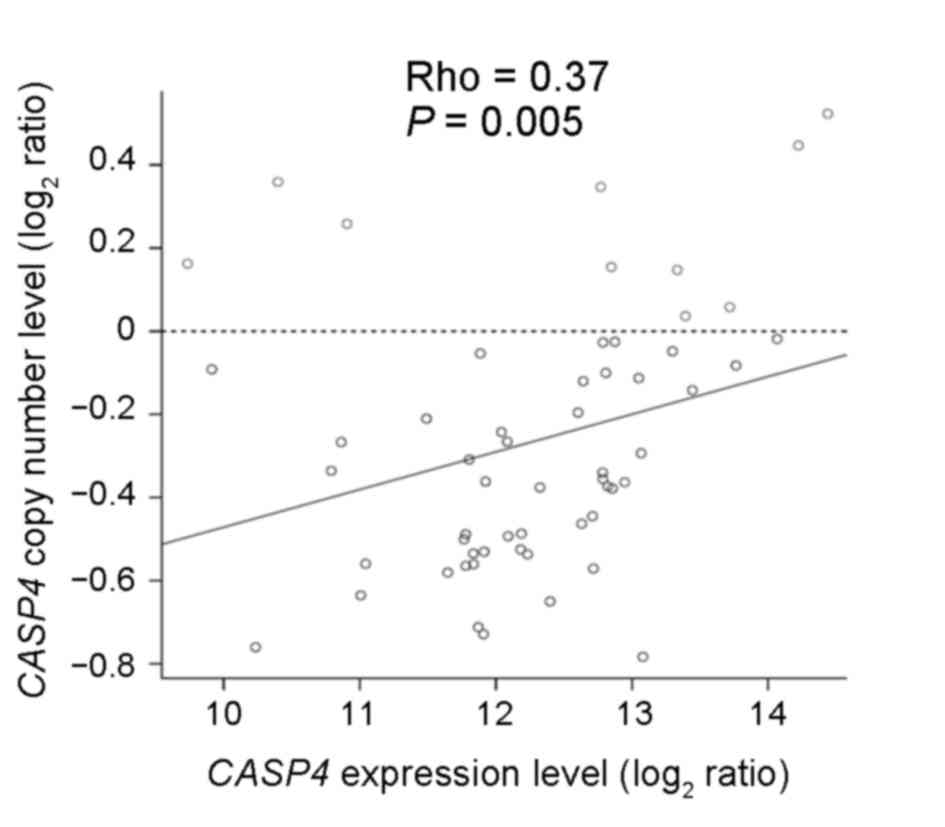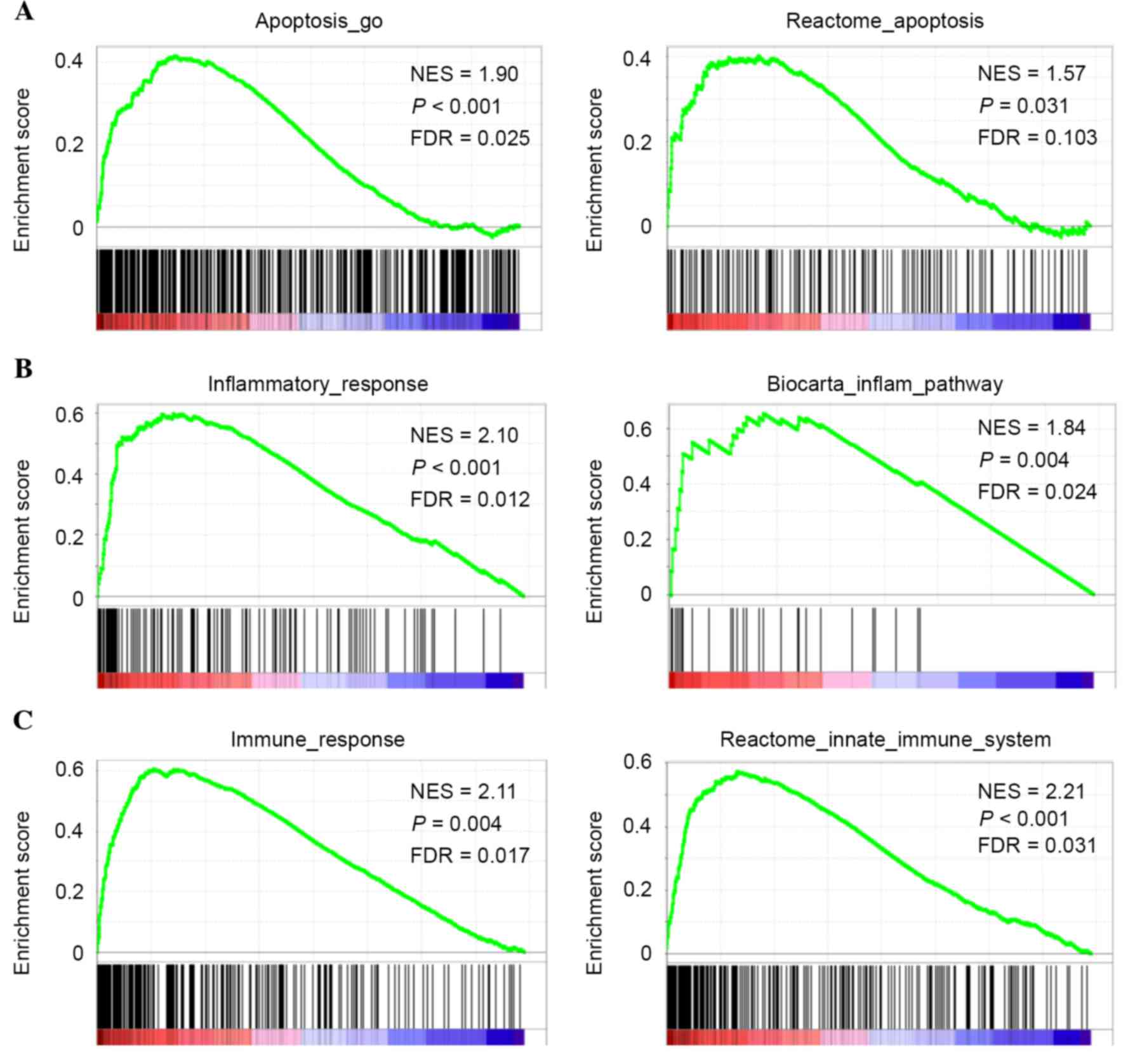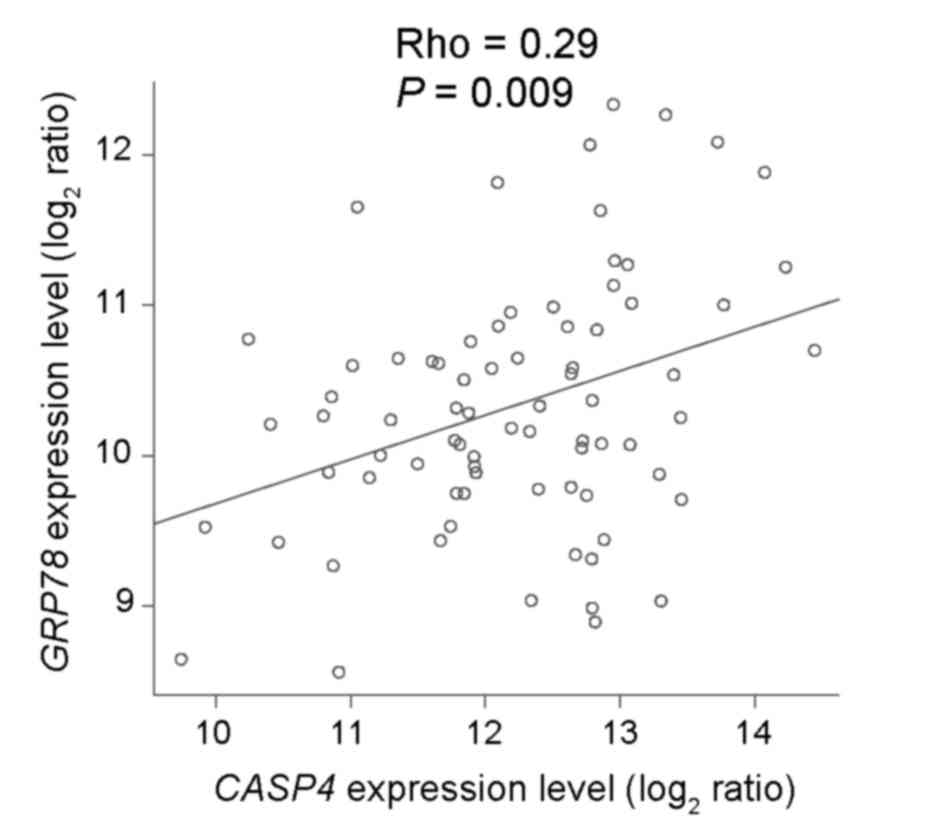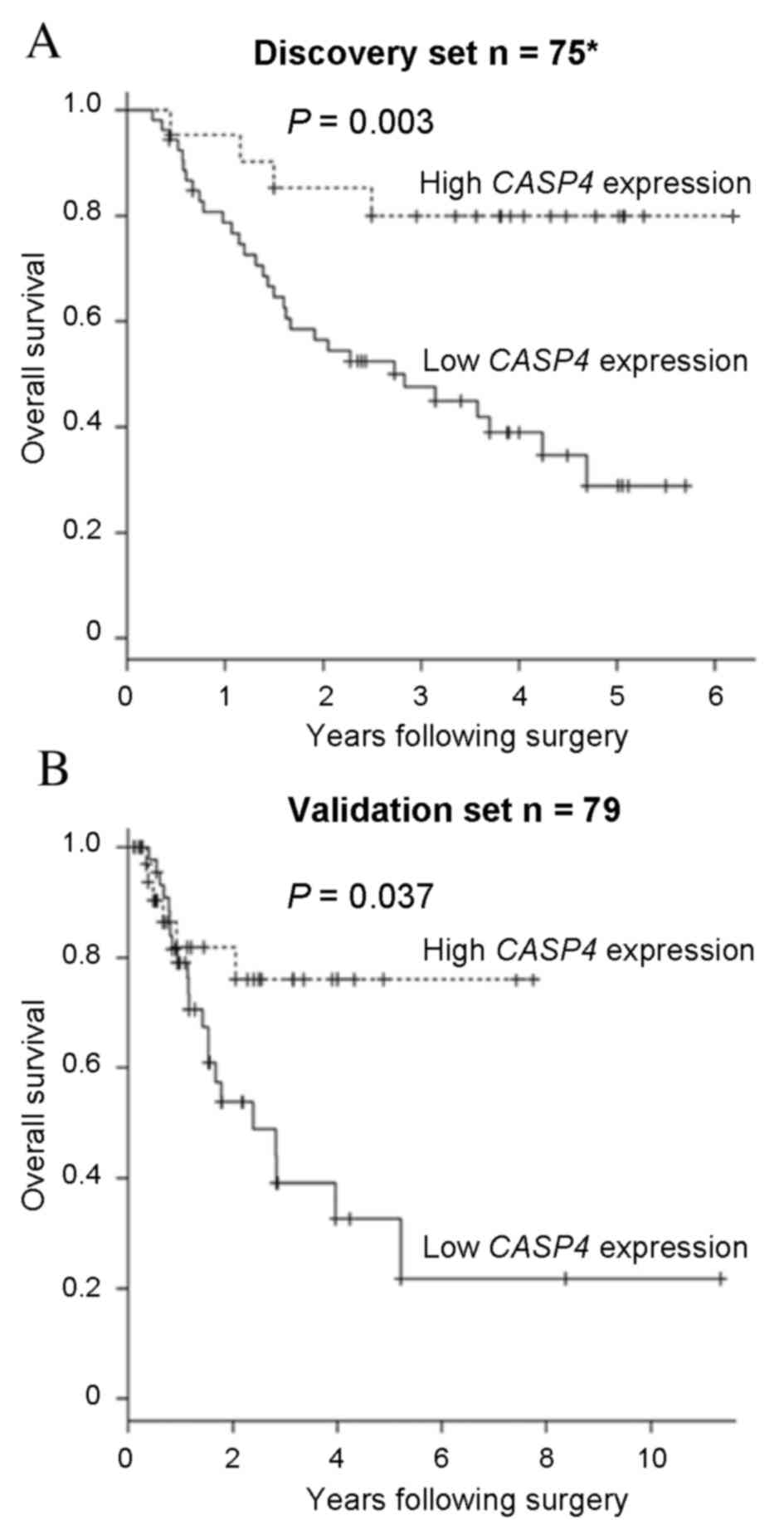The loss of CASP4 expression is associated with poor prognosis in esophageal squamous cell carcinoma
- Authors:
- Published online on: January 25, 2017 https://doi.org/10.3892/ol.2017.5646
- Pages: 1761-1766
Abstract
Introduction
The incidence of esophageal squamous cell carcinoma (ESCC) was ~24.4 males and ~4 females per 100,000 individuals in Japan in 2004; 3.4% of mortalities from all malignant neoplasms are due to ESCC (1). ESCC has high biological malignant potential amongst digestive tract cancers due to the frequent involvement of lymph node metastasis and tumor invasion of adjacent organs at the early stages (2). Therefore, it is crucial to identify biomarkers for predicting the malignant potential of ESCC.
DNA copy number alterations, which are associated with the dysregulation of gene expression, are considered to have a critical role in the pathogenesis of human cancers (3). The amplification and overexpression of human epidermal growth factor receptor 2 (HER2) are associated with poor prognosis in patients with breast cancer, and HER2 is an effective therapeutic target for trastuzumab (4). In ESCC, integrative analysis of copy number and gene expression profiles may facilitate the identification of genes associated with tumor progression (5–7); the current study aimed to investigate the genetic and transcriptional alterations in ESCC.
The caspase-4 (CASP4) gene encodes a protein involved in immunity and inflammation (8). Previous studies into cell death have demonstrated that endoplasmic reticulum (ER) stress induces CASP4-mediated cell apoptosis (9–11). Although pro-apoptotic caspases are downregulated in certain cancers (12), few previous clinical studies have focused on CASP4. Notably, CASP4 expression is suppressed, and is associated with poor prognosis, in head and neck squamous cell carcinoma (13,14). Loss-of-function CASP4 mutations are rarely observed in colorectal cancers (15); however, the clinical significance and role of CASP4 have yet to be evaluated in ESCC. The aim of the present study was to elucidate the clinical role of CASP4 expression in ESCC. The association between the expression levels and copy number profiles of CASP4 in tumor samples was investigated. Furthermore, gene set enrichment analysis (GSEA) (16) was performed to identify the signaling pathways involved in CASP4 expression in ESCC; the association between the expression levels of ER stress markers and CASP4 was also analyzed. Finally, the present study assessed the significance of CASP4 expression levels in the prognosis of ESCC.
Materials and methods
Sample collection, DNA extraction and RNA extraction
ESCC tumor and adjacent tissue samples were collected from a total of 157 patients diagnosed with ESCC who underwent surgical resection at the following five institutions: Juntendo University Hospital (Tokyo, Japan), National Cancer Center (Tokyo, Japan), Kurume University Hospital (Kurume, Japan), Saitama Cancer Center (Saitama, Japan), and Kagoshima University Medical and Dental Hospital (Kagoshima, Japan). The mean age of the patients was 65.5 years (age range, 40–83 years), with a 137:17 male:female ratio (clinical information was available for 154/157 patients). ESCC tissues samples with tumor stages T1−T4 were included in the study. The tissue samples were randomly divided into two sets, with 78 samples included in the discovery set (clinical information including survival profile was available for 75/78 cases) and 79 samples in the validation set (clinical information was available for 79 cases); each dataset included the above-mentioned institutions. In the discovery set, gene expression profiles were analyzed using human gene expression microarrays (Whole Human Genome Microarray kit; 4×44; cat. no. G4112F; Agilent Technologies, Inc., Santa Clara, CA, USA). Array-comparative genomic hybridization (CGH) was also performed in 57/78 cases in the discovery set, as genomic DNA was available in these cases. In the validation set, CASP4 expression levels were analyzed using reverse transcription quantitative polymerase chain reaction (RT-qPCR).
Cells were isolated using a laser microdissection system (LMD; Leica Microsystems GmbH, Wetzlar, Germany) and DNA and RNA samples were purified and extracted using a QIAamp DNA Micro kit (Qiagen GmbH, Hilden, Germany) and an RNeasy Micro kit (Qiagen GmbH). Written informed consent was obtained from all patients and the study protocol was reviewed and approved by the internal review board of Kyushu University (Fukuoka, Japan).
Array-CGH and copy number analysis
Genomic DNA samples from 57 tumor specimens were analyzed using array-CGH. The genomic DNA of 3 samples from the normal esophageal mucosa was also analyzed and used as a reference for the array-CGH. DNA labeling and hybridization were performed using a Genome Microarray kit 244K (Agilent Technologies, Inc.). The data were evaluated using a microarray scanner (Agilent Technologies, Inc.) and analyzed using the Feature Extraction software version 9.1 (Agilent Technologies, Inc.).
Expression array
An expression array was performed using the 78 tumor samples in the discovery set. The total RNA extracted using the LMD technique was reverse transcribed to generate double-stranded cDNA. Amplification was then performed using a T7 RNA polymerase (Agilent Technologies, Inc.), and the product was converted to cyanine-labeled cRNA. The labeled cRNA was fragmented and hybridized to an oligonucleotide microarray (Whole Human Genome Microarray kit, 4×44; G4112F; Agilent Technologies, Inc.). Fluorescence intensities were obtained using an Agilent DNA microarray scanner and subjected to quantile normalization.
GSEA
GSEA was performed using the gene expression data from the discovery set to investigate how signaling pathways were differentially regulated depending on the expression levels of CASP4 in ESCC. The present study used a continuous-type class file with the CASP4 profile to phenotype labels in GSEA; the expression level of CASP4 in each sample was used as an input data in GSEA. The gene sets extracted from the Broad Institute (Cambridge, MA, USA) database (http://software.broadinstitute.org/gsea/msigdb/collections.jsp) included gene sets based on the gene ontology pathway (apoptosis_go, inflammatory_response, and immune_response), gene sets annotated by the reactome pathway (reactome_apoptosis and reactome_innate_immune_system) and a gene set based on the biocarta pathway, biocarta_inflam_pathway.
RT-qPCR
RT-qPCR was performed using a LightCycler system (Roche Diagnostics, Indianapolis, IN, USA) and a LightCycler 480 Probes Master kit (Roche Diagnostics) according to the manufacturer's protocol. The following thermal cycling conditions were used: Initial denaturation at 95°C for 10 min, followed by 45 cycles of denaturation at 95°C for 10 sec, annealing at 60°C for 30 sec, and extension at 40°C for 30 sec. The CASP4 primers were as follows: Forward, 5′-TTCCTGGCAATTGAAAATGG-3′, and reverse, 5′-TGCAAGCTGTACTAATGAAGGTG-3′. The concentrations of CASP4 in each sample were calculated by plotting their crossing points against the standard curve from a single experiment. The CASP4 mRNA level was normalized to the internal standard, glyceraldehyde 3-phosphate dehydrogenase assessed using the following primers: GAPDH forward, 5′-AGCCACATCGCTCAGACAC-3′, and reverse, 5′-GCCCAATACGACCAAATCC-3′.
Statistical analysis
Student's t-tests and Fisher's exact tests were used to determine significant differences between the groups. The Kaplan-Meier method was used to evaluate the survival rates and the survival curves were compared using log-rank tests. Overall survival was calculated from the date of surgical resection to date of death/final follow-up. Statistical analysis was performed using JMP version 5 software (SAS Institute, Buckinghamshire, UK). P<0.05 was considered to indicate a statistically significant result.
Results
Copy number loss inhibits CASP4 expression in ESCC
The copy number alterations accompanying changes in CASP4 gene expression were analyzed using the array-CGH and the expression array data from the ESCC discovery set. The present study demonstrated that CASP4 copy number loss occurred in 47/57 ESCC samples and that there was a significant association between the copy number and expression levels (Spearman's correlation, rho=0.37; P=0.005; Fig. 1). In ESCC, copy number loss appeared to suppress CASP4 gene expression, suggesting that CASP4 may act as a tumor-suppressor gene.
Higher CASP4 expression levels were significantly associated with the signaling pathways involved in apoptosis, inflammatory responses, and immune responses in ESCC
GSEA of the 78 ESCC samples from the discovery set revealed that certain gene sets involved in the apoptotic signaling pathway were significantly upregulated in ESCCs expressing high levels of CASP4 as follows: Apoptosis_go, P<0.001, false discovery rate (FDR)=0.025; reactome_apoptosis P=0.031, FDR=0.103 (Fig. 2A). The present study also demonstrated that higher CASP4 expression was significantly associated with the enrichment of gene sets involved in the inflammatory response, including inflammatory_response (P<0.001; FDR=0.012) and biocarta_inflam_pathway (P=0.004; FDR=0.024; Fig. 2B), and of gene sets involved in the immune response, including immune_response (P=0.004; FDR=0.017) and reactome_innate_immune_system (P<0.001; FDR=0.031; Fig. 2C). These data were consistent with CASP4 being an inflammatory caspase and a critical mediator of the innate immune response (8). The current study subsequently evaluated the association between the expression levels of CASP4 and the ER chaperone glucose-regulated protein (GRP) 78, which is used as an ER stress marker (9–11,17). CASP4 expression levels were positively associated with GRP78 expression levels (Spearman's correlation, rho=0.29; P=0.009; Fig. 3), demonstrating that CASP4 has a role in regulating ER stress-induced cell death in ESCC.
CASP4 expression levels predict the prognosis of patients with ESCC
To examine the clinical significance of CASP4 expression in ESCC, a survival analysis was performed. The present study identified that low CASP4 expression levels were significantly associated with a poor overall survival rate in the discovery set (P=0.003; Fig. 4A). To investigate the clinical significance of CASP4 expression levels in ESCC, the validation set was also analyzed. Low CASP4 expression levels were observed to be significantly associated with lymphatic invasion (P=0.003; Table I). The overall survival rate for the validation set was also analyzed, and revealed no significant differences in the overall survival rate between the discovery and validation sets (P=0.805). Concordant with the discovery set data, the CASP4 low expression group had a significantly poorer overall survival rate, compared with the CASP4 high expression group, in the validation set (P=0.037; Fig. 4B). These results suggest that CASP4 may have a tumor suppressor role in ESCC.
Discussion
The current study demonstrated that the downregulation of CASP4 expression levels is associated with ESCC progression. The gene expression and copy number profiles of clinical tissue samples were analyzed using a bioinformatics approach and demonstrated that the copy number loss of CASP4 was associated with the decreased expression levels of CASP4 observed in ESCC. The CASP4 low expression group had a poor prognosis, compared with the CASP4 high expression group; these results were reproducible in each clinical ESCC cohort. These results suggest that CASP4 may function as a tumor-suppressor gene and may be a useful biomarker for predicting the prognosis in ESCC.
CASP4 has been previously reported to induce cell death (9–11). A few studies have identified that CASP4 is involved in ER stress-induced apoptosis in neurodegenerative disorders (9), muscular dystrophy (10) and retinal pigment epithelial cells (11). Concordantly, the present study demonstrated that CASP4 expression levels were significantly associated with the apoptotic signaling pathway and the expression levels of GRP78 in ESCC. Furthermore, CASP4 encodes a protein involved in inflammation and immune responses (8). Kobayashi et al (18) reported that CASP4 is involved in the innate immune response and inflammatory cell death in bacterial infection. Similarly, the current study indicated that CASP4 was significantly associated with the inflammatory and immune responses that may contribute to the inhibition of ESCC progression.
The data demonstrates that low CASP4 expression is significantly associated with lymphatic invasion. We hypothesized that CASP4 expression may contribute to the early phase of ESCC progression, as cell death, including apoptosis, is more frequent during the early phase of tumor progression, and lymphatic invasion occurs earlier than lymph node metastasis. Therefore, it is possible that CASP4 expression levels may predict not only the prognosis, but also early phase tumor progression in ESCC.
In conclusion, the current study indicated that CASP4 may be a tumor-suppressor gene associated with the signaling pathways underlying apoptosis, inflammatory responses and immune responses in ESCC. The results also suggested that ER stress induces CASP4-mediated apoptosis. CASP4 expression may therefore be a useful clinical biomarker for predicting the prognosis of patients with ESCC.
Acknowledgements
This study used the supercomputing resources provided by the Human Genome Center, Institute of Medical Science, University of Tokyo. This study was supported by the following foundations: Grants-in-Aid for Scientific Research (grant nos. 26861003, 15H04921, 25461953 and 21229015); Funding Program for Next Generation World-Leading Researchers (grant no. LS094).
References
|
Kuwano H, Nishimura Y, Oyama T, Kato H, Kitagawa Y, Kusano M, Shimada H, Takiuchi H, Toh Y, Doki Y, et al: Guidelines for diagnosis and treatment of carcinoma of the esophagus April 2012 edited by the Japan Esophageal Society. Esophagus. 12:1–30. 2015. View Article : Google Scholar : PubMed/NCBI | |
|
Enzinger PC and Mayer RJ: Esophageal cancer. N Engl J Med. 349:2241–2252. 2003. View Article : Google Scholar : PubMed/NCBI | |
|
Solomon E, Borrow J and Goddard AD: Chromosome aberrations and cancer. Science. 254:1153–1160. 1991. View Article : Google Scholar : PubMed/NCBI | |
|
Yan M, Parker BA, Schwab R and Kurzrock R: HER2 aberrations in cancer: Implications for therapy. Cancer Treat Rev. 40:770–780. 2014. View Article : Google Scholar : PubMed/NCBI | |
|
Sawada G, Niida A, Hirata H, Komatsu H, Uchi R, Shimamura T, Takahashi Y, Kurashige J, Matsumura T, Ueo H, et al: An integrative analysis to identify driver genes in esophageal squamous cell carcinoma. PLoS One. 10:e01398082015. View Article : Google Scholar : PubMed/NCBI | |
|
Hu N, Wang C, Ng D, Clifford R, Yang HH, Tang ZZ, Wang QH, Han XY, Giffen C, Goldstein AM, et al: Genomic characterization of esophageal squamous cell carcinoma from a high-risk population in China. Cancer Res. 69:5908–5917. 2009. View Article : Google Scholar : PubMed/NCBI | |
|
Shi ZZ, Shang L, Jiang YY, Hao JJ, Zhang Y, Zhang TT, Lin DC, Liu SG, Wang BS, Gong T, et al: Consistent and differential genetic aberrations between esophageal dysplasia and squamous cell carcinoma detected by array comparative genomic hybridization. Clin Cancer Res. 19:5867–5878. 2013. View Article : Google Scholar : PubMed/NCBI | |
|
McIlwain DR, Berger T and Mak TW: Caspase functions in cell death and disease. Cold Spring Harb Perspect Biol. 5:a0086562013. View Article : Google Scholar : PubMed/NCBI | |
|
Hitomi J, Katayama T, Eguchi Y, Kudo T, Taniguchi M, Koyama Y, Manabe T, Yamagishi S, Bando Y, Imaizumi K, et al: Involvement of caspase-4 in endoplasmic reticulum stress-induced apoptosis and Abeta-induced cell death. J Cell Biol. 165:347–356. 2004. View Article : Google Scholar : PubMed/NCBI | |
|
Moorwood C and Barton ER: Caspase-12 ablation preserves muscle function in the mdx mouse. Hum Mol Genet. 23:5325–5341. 2014. View Article : Google Scholar : PubMed/NCBI | |
|
Bian ZM, Elner SG and Elner VM: Dual involvement of caspase-4 in inflammatory and ER stress-induced apoptotic responses in human retinal pigment epithelial cells. Invest Ophthalmol Vis Sci. 50:6006–6014. 2009. View Article : Google Scholar : PubMed/NCBI | |
|
Philchenkov A, Zavelevich M, Kroczak TJ and Los M: Caspases and cancer: Mechanisms of inactivation and new treatment modalities. Exp Oncol. 26:82–97. 2004.PubMed/NCBI | |
|
Li H, Wang J, Zeng Z, Fu X and Zhang W: Expression and correlation of apoptosis-related gene c-IAP2 and caspase-4 in head and cervical undifferentiation squamous cell carcinoma. Lin Chuang Er Bi Yan Hou Ke Za Zhi. 17:739–741. 2003.(In Chinese). PubMed/NCBI | |
|
Li H, Zeng ZH, Wang LH and Wang JQ: Expression and correlation of apoptosis-related gene c-IAP2 and caspase-4 in sinonasal squamous carcinoma. Zhonghua Er Bi Yan Hou Ke Za Zhi. 39:324–327. 2004.(In Chinese). PubMed/NCBI | |
|
Soung YH, Jeong EG, Ahn CH, Kim SS, Song SY, Yoo NJ and Lee SH: Mutational analysis of caspase 1, 4, and 5 genes in common human cancers. Hum Pathol. 39:895–900. 2008. View Article : Google Scholar : PubMed/NCBI | |
|
Subramanian A, Tamayo P, Mootha VK, Mukherjee S, Ebert BL, Gillette MA, Paulovich A, Pomeroy SL, Golub TR, Lander ES and Mesirov JP: Gene set enrichment analysis: A knowledge-based approach for interpreting genome-wide expression profiles. Proc Natl Acad Sci USA. 102:15545–15550. 2005. View Article : Google Scholar : PubMed/NCBI | |
|
Moenner M, Pluquet O, Bouchecareilh M and Chevet E: Integrated endoplasmic reticulum stress responses in cancer. Cancer Res. 67:10631–10634. 2007. View Article : Google Scholar : PubMed/NCBI | |
|
Kobayashi T, Ogawa M, Sanada T, Mimuro H, Kim M, Ashida H, Akakura R, Yoshida M, Kawalec M, Reichhart JM, et al: The Shigella OspC3 effector inhibits caspase-4, antagonizes inflammatory cell death, and promotes epithelial infection. Cell Host Microbe. 13:570–583. 2013. View Article : Google Scholar : PubMed/NCBI |













